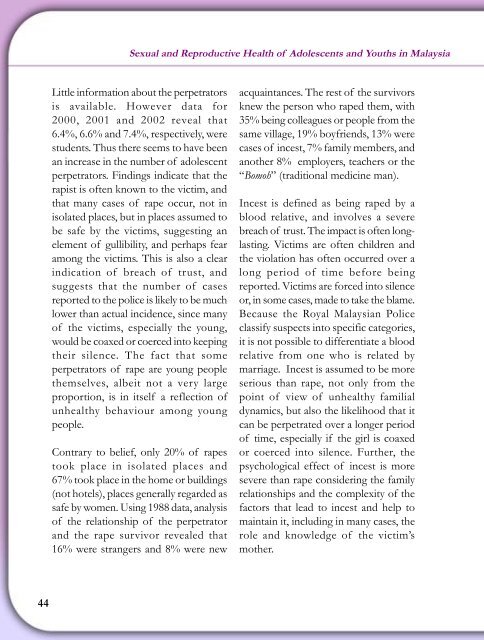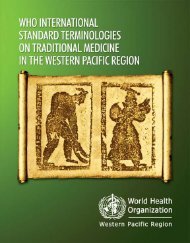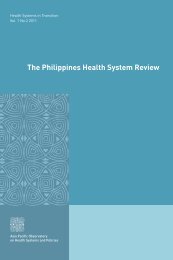Download pdf, 989kb - WHO Western Pacific Region - World Health ...
Download pdf, 989kb - WHO Western Pacific Region - World Health ...
Download pdf, 989kb - WHO Western Pacific Region - World Health ...
Create successful ePaper yourself
Turn your PDF publications into a flip-book with our unique Google optimized e-Paper software.
Sexual and Reproductive <strong>Health</strong> of Adolescents and Youths in Malaysia<br />
Little information about the perpetrators<br />
is available. However data for<br />
2000, 2001 and 2002 reveal that<br />
6.4%, 6.6% and 7.4%, respectively, were<br />
students. Thus there seems to have been<br />
an increase in the number of adolescent<br />
perpetrators. Findings indicate that the<br />
rapist is often known to the victim, and<br />
that many cases of rape occur, not in<br />
isolated places, but in places assumed to<br />
be safe by the victims, suggesting an<br />
element of gullibility, and perhaps fear<br />
among the victims. This is also a clear<br />
indication of breach of trust, and<br />
suggests that the number of cases<br />
reported to the police is likely to be much<br />
lower than actual incidence, since many<br />
of the victims, especially the young,<br />
would be coaxed or coerced into keeping<br />
their silence. The fact that some<br />
perpetrators of rape are young people<br />
themselves, albeit not a very large<br />
proportion, is in itself a reflection of<br />
unhealthy behaviour among young<br />
people.<br />
Contrary to belief, only 20% of rapes<br />
took place in isolated places and<br />
67% took place in the home or buildings<br />
(not hotels), places generally regarded as<br />
safe by women. Using 1988 data, analysis<br />
of the relationship of the perpetrator<br />
and the rape survivor revealed that<br />
16% were strangers and 8% were new<br />
acquaintances. The rest of the survivors<br />
knew the person who raped them, with<br />
35% being colleagues or people from the<br />
same village, 19% boyfriends, 13% were<br />
cases of incest, 7% family members, and<br />
another 8% employers, teachers or the<br />
“Bomoh” (traditional medicine man).<br />
Incest is defined as being raped by a<br />
blood relative, and involves a severe<br />
breach of trust. The impact is often longlasting.<br />
Victims are often children and<br />
the violation has often occurred over a<br />
long period of time before being<br />
reported. Victims are forced into silence<br />
or, in some cases, made to take the blame.<br />
Because the Royal Malaysian Police<br />
classify suspects into specific categories,<br />
it is not possible to differentiate a blood<br />
relative from one who is related by<br />
marriage. Incest is assumed to be more<br />
serious than rape, not only from the<br />
point of view of unhealthy familial<br />
dynamics, but also the likelihood that it<br />
can be perpetrated over a longer period<br />
of time, especially if the girl is coaxed<br />
or coerced into silence. Further, the<br />
psychological effect of incest is more<br />
severe than rape considering the family<br />
relationships and the complexity of the<br />
factors that lead to incest and help to<br />
maintain it, including in many cases, the<br />
role and knowledge of the victim’s<br />
mother.<br />
44

















